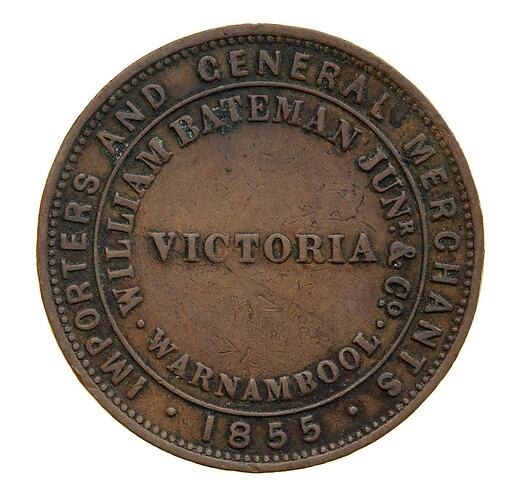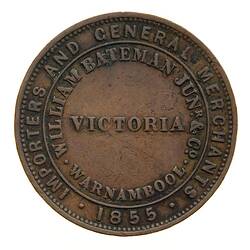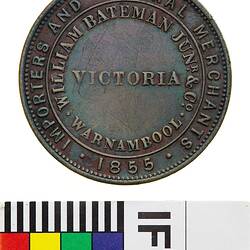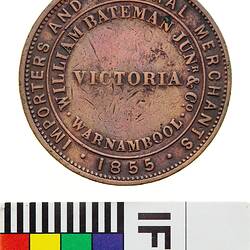William Bateman and his two sons William Junior and James arrived in Victoria from Yorkshire in 1853, bringing enough capital to start a store. The Bateman family had been involved in the woollen trade in Yorkshire prior to coming to Australia, and according to Turnbull, they brought a large volume of stock with them. Inward bound passenger lists held by the Public Records Office of Victoria show that eight passengers with the last name Bateman arrived on board the Prince Arthur in May that year.
In 1853 William Junior bought into a Warrnambool business belonging to Thomas Denny, known as Denny and Co.'s. Denny had recently ended his partnership with Mr. William McDowell, a general merchant whose main business was in Portland. William Senior bought Denny out of the business for £6000 in October 1853.
The business was run under the name of William Bateman, Junior and Co., although William Senior was also active in the business. Bateman and Co. operated from their premises in Banyan Street with stores at the jetty.Their business was located in Banyan Street, and they carried a wide range of goods, including hardware, drapery, machinery and groceries. 'They also had a large portfolio of crop financing and other loan advances.' (Turnbull, 1992, p.35)
The business was prosperous, and by 1855 it was one of the leading businesses in the district. William Junior Invested almost the entire profits of the business in land speculation, which was rife in the Western District at that time, and ran the business on credit from the banks. According to Turnbull at the end of 1854 'the company's overdraft was £84,200. The following year it was £100,855.' (Turnbull, 1992, p.36)
Despite the business' prominence in the district, in September 1855 the Australasian Bank refused to provide additional funds. Part of the problem for Bateman and Co. was William Junior's habit of making loans to inexperienced farmers against the expected success of their crops, or to builders against their stock of materials. This was not a sound policy, as many of those receiving the loans from Bateman were unable to meet their debts to him. One example is the notice of indenture published on 7 September 1855, in which John Frizzell 'did bargain, sell and assign.' He successfully obtained an overdraft of £20,000 from the Bank of Victoria, and by April of the following year owed the banks over £120,000 in total.
On 28 August 1856 the Bank of Victoria refused to carry this level of debt, and called on Bateman to repay a portion of the money he owed. Bateman paid some of this portion, but the next month took the unusual step of selling the business to his clerk and nephew, Thomas W. Sellars (Warrnambool Examiner, 26 September 1856).
Under a cloud of suspicion Bateman & Co.'s businesses were closed on 26 September 1856, leading to the closure of ten other businesses in Warrnambool (Turnbull 1992, p. 35). Bateman appeared in court in Melbourne to face charges brought against him by the Banks of Victoria and Australasia.
After an initial hearing, Bateman returned to Warrnambool to collect additional papers relating to the case. The night before he was to return to Melbourne, the morning of November 4, the business burnt to the ground. Bateman & Co.'s premises, and merchandise to the value of £30,000 was consumed by the blaze. The Warrnambool Examiner of 7 November 1856 carried both a front page story on the fire itself, and a report on the inquest held on 6 November.
The story was presented as 'one of the most fearful visitations which has ever befallen this Town and District', and drew the reader's attention to the bravery of the locals who assisted to raise the alarm and remove goods such as draperies, and gun powder of which 'about 20 barrels were carted away, which had they exploded, would have blown down most of the houses,' (Warrnambool Examiner, 7 November 1856, p.1). The Examiner also noted that 'All the account books are saved. The iron safes (two very superior ones, we believe) can now be seen through the flames'. The inquest found that 'the fire originated near the watercloset, but there is no evidence to show from what cause' (Warrnambool Examiner, 7 November 1856, p.2). Mr. Bateman was not called as a witness. Following the fire, Mr. William Bateman Junior was found guilty by a Melbourne court on 18 December 1856, of fraudulent dealing in his sale of his business to Mr. Sellars.
After he discharged his debts, Bateman established a substantial potato purchasing business in Belfast (Port Fairy). He later established another store in Warrnambool in partnership with Mr. Smith, (Bateman, Smith & Co.) but this failed and they filed for bankruptcy in 1874. After this Bateman is said to have travelled to New Zealand and then to either South Australia or South America in search of further opportunities.
References:
Gardner, F. (1910). 'Trade tokens and the Firms Who Issued Them', Australian Storekeepers And Traders Journal, 31 October, p.1. Reprinted in: Australian Coin Review. July 1969, p.21.
Turnbull, J. (1992). 'Two tokens of Australia Felix', Australian Coin Review, September, pp.34-36.
The Argus, 7 September 1855, p.7.
The Warrnambool Examiner and Western Districts Advertiser, 26 September 1856, p.1.
The Warrnambool Examiner and Western Districts Advertiser, 7 November 1856, p.2.
The Herald, December 12 1856, p.7.
The Warrnambool Examiner and Western Districts Advertiser, 16 December 1856, p.2.
PROV Inward Bound Immigrants Index (British Ports), VPRS 7666. Microfiche B037/005 and B038/012.
Sharples, J. (1993). 'Catalogue of Victorian Trade Tokens.' Journal of the Numismatic Association of Australia. Vol.7. December, p.76.
Hope, John (2005). 'Bateman', unpublished MSS, 3 pps.
More Information
-
Keywords
-
Localities
-
Authors
-
Article types





